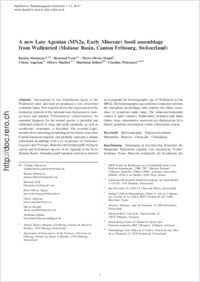A new Late Agenian (MN2a, Early Miocene) fossil assemblage from Wallenried (Molasse Basin, Canton Fribourg, Switzerland)
- Mennecart, Bastien Natural History Museum of Fribourg, Switzerland - Department of Geosciences, Earth Sciences, University of Fribourg, Switzerland - Centre de Recherches sur la Paléobiodiversité et les Paléoenvironnements, Muséum National d'Histoire Naturelle, Paris, France
- Yerly, Bertrand Natural History Museum of Fribourg, Switzerland - Laboratoire Romand de Dendrochronologie, Moudon, Switzerland
- Mojon, Pierre-Olivier Rue du Centre 81, 2405, La Chaux du Milieu, Switzerland
- Angelone, Chiara Institut Català de Paleontologia, Cerdanyola del Vallès, Barcelona, Spain
- Maridet, Olivier Department of Geosciences, Earth Sciences, University of Fribourg, Switzerland - Jurassica Museum, Porrentruy, Switzerland
- Böhme, Madelaine Eberhard Karls University, Tübingen, Germany - Senckenberg Center for Human Evolution and Palaeoenvironment HEP Tübingen , Germany
- Pirkenseer, Claudius Natural History Museum of Fribourg, Switzerland - Paléontologie A16, Office de la Culture, Canton du Jura, Porrentruy, Switzerland - Department of Geosciences, Earth Sciences, University of Fribourg, Switzerland
-
22.10.2015
Published in:
- Paläontologische Zeitschrift. - 2016, vol. 90, p. 101-123
English
Excavations of two fossiliferous layers in the Wallenried sand- and marl pit produced a very diversified vertebrate fauna. New material allows the reassessment of the taxonomic position of the ruminant taxa Andegameryx andegaviensis and endemic Friburgomeryx wallenriedensis. An emended diagnosis for the second species is provided and additional material of large and small mammals, as well as ectothermic vertebrates, is described. The recorded Lagomorpha show interesting morphological deviations from other Central European material, and probably represent a unique transitional assemblage with a co-occurrence of Titanomys, Lagopsis and Prolagus. Rodentia and Eulipotyphla belong to typical and well-known species of the Agenian of the Swiss Molasse Basin. Abundant small mammal teeth have allowed us to pinpoint the biostratigraphic age of Wallenried to late MN2a. The biostratigraphic age conforms to data derived from the charophyte assemblages and confirms the oldest occurrence of venomous snake fangs. The palaeoenvironmental context is quite complex. Sedimentary structures and fauna (fishes, frogs, salamanders, ostracods) are characteristic for a humid, lacustrine environment within a flood plain system.
- Faculty
- Faculté des sciences et de médecine
- Department
- Département de Géosciences
- Language
-
- English
- Classification
- Palaeontology
- License
-
License undefined
- Identifiers
-
- RERO DOC 257940
- DOI 10.1007/s12542-015-0275-3
- Persistent URL
- https://folia.unifr.ch/unifr/documents/304633
Statistics
Document views: 109
File downloads:
- pdf: 797
